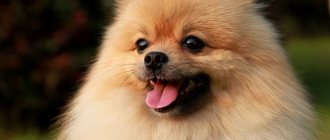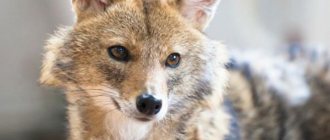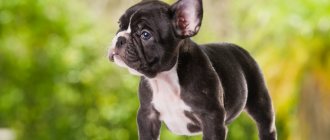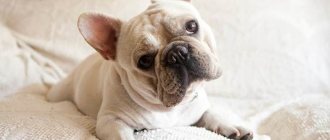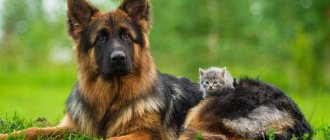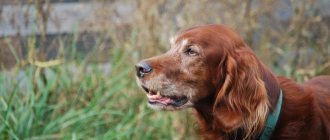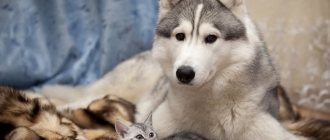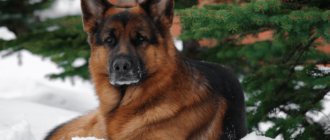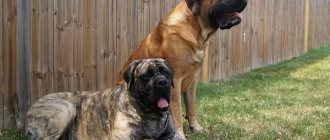Description of the Japanese Spitz breed
Popularity 105th place among 263 dog breeds
Lifespan:
14-16 years old
Breed group:
Decorative
Height:
28-36 cm
Country of origin:
Japan
Average price:
40-50 thousand rubles
Weight:
5-6 kg
Latest articles Cat health
Rabies vaccination for cats: choice of vaccine, necessity, schedule 01/22/2022 4 0 0
Selection and adaptation
TOP 20 best cat breeds for families with children 01/22/2022 25 0 0
Pros and cons of the breed
The positive aspects of these dogs include:
- good health;
- goodwill;
- sociability;
- charming appearance;
- unpretentiousness in terms of care.
There are no perfect dogs, which is why Spitz dogs have a number of disadvantages, such as high cost, heavy shedding and the need to purchase clothes for walking in winter.
Key facts
The appearance of this dog will not leave anyone indifferent. Wool the color of the first snow, black beady eyes, a ring tail - all these characteristics of the Japanese Spitz breed are combined with maximum focus on people, making the dog an excellent friend and full member of the family. The breed also has another name: in its homeland, in the Land of the Rising Sun, it is called Nihon Supitsu.
Unlike most small breeds, these animals do not bark for no reason: they only voice their voices to attract the attention of their owner.
Dogs are very strongly attached to their owner and are ready not to leave him a single step, but at the same time they are not intrusive and will happily lie quietly at his feet. If the dog feels that he has been deprived of attention, he can play pranks so that the person shows interest in him.
The description of the Japanese Spitz breed says that the dogs are distinguished by neatness and cleanliness. And a special protective layer that protects the coat from dirt helps to maintain the purity of the coat.
Animals have good thinking, which allows them to easily learn various commands and tricks, and in their homeland, many of them compete in agility - overcoming a kind of obstacle course for speed and quality. This gives the Spitz great pleasure.
Since pets do not have a hunting instinct, this allows them to coexist perfectly in the same apartment with cats and other contact breeds of dogs, as well as to walk surrounded by their own kind.
These dogs belong to the category of small breeds and are small in size. The height at the withers for a male is 34-36 cm, for a female - 28-32 cm. The weight of a Japanese Spitz ranges from 6-8 kg for males and 5-6 for females.
The average life expectancy of a Japanese Spitz is 14-16 years, meaning these dogs are considered long-lived. It happens that they can live up to 17-18 years.
Related breeds
The Spitz family is like a colorful kaleidoscope. The size of representatives ranges from dwarf to those whose height at the withers reaches more than 50 centimeters. Spitz breeds include:
- German;
- Pomeranian;
- Finnish;
- American Eskimo;
- Italian Spitz Volpino;
- Eurasian;
- Greenlandic;
- Karelian-Finnish Laika;
- Karelian bear dog or Karelian bear husky.
Spitz varieties
The peculiarity of the Japanese Spitz is that it is suitable for any dog owner. These dogs are able not only to cheer up, but also to bravely protect the owner. A mischievous fluffy dog with a sharp mind will be an ideal family pet or a wonderful companion and understanding interlocutor for a lonely person.
History of the origin of the Japanese Spitz
The country of origin is Japan, as evidenced by the name of the breed itself. It is considered quite young - Japanese specialists received their first representatives approximately in the 30s of the twentieth century. They never told the world what breed formed the basis of these snow-white beauties. Most likely, their closest relatives are German Spitz.
An interesting fact is that until the 40s there was constant selection and changes in the type of animals, which did not make it possible to establish a single standard. That is why it was adopted in 1948 in Japan, but the World Canine Organization agreed to it only in 1964. The American Canine Association flatly refused to classify these dogs as Spitz-type dogs.
In Russia, these dogs first appeared in the circus arena. The famous trainer Nikolai Pavlenko worked with them, and after successful performances, he decided to delve into breeding work, acquiring several high-level breeding sires. Later, one of his dogs became Philip Kirkorov’s pet.
Owner reviews about the breed
The first owner of a Japanese Spitz in Russia was trainer Nikolai Pavlenko. He described his experience this way:
This was my first Japanese Spitz dog. We have had and still have dozens of dogs... All of them are loved. And Rikki was human. I was in seventh heaven. Nothing but happiness and joy from communication...
Alena Voronetskaya, Spitz breeder (kennel “Sakura Show”):
I didn't have dogs, only ordinary "noble" cats. But, like many, I dreamed of a dog. I really liked Samoyeds, but they are too large for an apartment. I also liked Pomeranian Spitz, but that was also not the case... And one day I saw a Japanese Spitz on the Internet - and the mosaic came together: white, fluffy and Spitz.
Eva Pavlovna:
We gave this cute creature to my sister for her birthday, but after seeing how cheerful, funny and playful this baby is, we decided to get one for ourselves. They have a certain innate aristocracy, they are very smart, clean and don’t shit anywhere (about going to the toilet, they somehow immediately found a common language with him).
If you get a puppy, you need to remember about basic care, in addition to feeding (we feed with good food, which was recommended by the breeder). We clean the eyes daily, check the ears once a week, carry out prevention against worms and fleas (once every 3 months), vaccinations according to age.
The only negative, in my opinion, is the price of a purebred puppy, but believe me, it’s worth it!
Appearance of a Japanese Spitz
General impressions
These are short animals with snow-white thick fur, a sharp muzzle, stable pointed ears and a small fluffy tail. In the photo, the Japanese Spitz is easy to distinguish from other breeds.
Despite the fact that the Asian handsome man is a Spitz, he has some differences from the standard representatives. This is a dog of a stretched rather than squared format, with a non-standard eye shape and a unique coat color.
Head
Representatives of this breed have a medium-sized, round head. The muzzle is pointed and wedge-shaped. The transition is clearly pronounced. Classic scissor bite, 6x6.
The nose is small, black, sometimes with a purple tint. The lips close tightly. The eyes are almond-shaped, set deep and slightly slanted. The black outline of the eyes is clearly drawn. The ears are small and set high.
Neck
Due to the thickness of the coat, it is slightly expressed. Quite strong, curved, not long.
Torso
The most important proportion in the dimensions of Japanese Spitz is the height to length ratio of 10:11. The format is elongated, the withers are slightly pronounced, the back line is straight. The lumbar region is dome-shaped. The chest is wide, round, deep set. The lowest point of the chest should be at the level of the dog's elbows. The belly is lean.
Forelegs
The shoulders have a good angle of inclination, the forearms are straight, parallel to each other, directly perpendicular to the surface. Elbows are pressed to the body. The pasterns are small but strong, the pads and claws are black.
Hind limbs
The hind legs are more powerful, strong, and the muscles are well defined. The hock joints are parallel to each other and at a relative angle.
Tail
It has the shape of a ring with one curl, covered with thick hair. A double curl is considered a critical disqualifying fault.
Movements
The movements are fast, active, the step is sweeping, the front legs do not cross the midline when running. The tops of the croup and withers should be at the same level. During active movements, the dog does not rake the soil with its paws and does not deviate from the straight path of movement.
Wool
It is represented by two layers - a thick, densely padded soft undercoat and a coarser and harsher outer coat. The extended part requires regular careful maintenance using special products. There are areas with short hair: pasterns, metatarsals, muzzle, ears, front part of the forearms.
Color
The only acceptable color of the Japanese Spitz according to the FCI breed standard: white, without any other inclusions or shades.
Size
The height of a male Japanese Spitz at the withers should be no lower than 32 cm and not exceed 36 cm. Optimal height is 33-34 cm. The female should be no lower than 28 cm, but not exceed 34 cm. The weight of male dogs should not fall below 6 kg , females – below 5 kg.
Any deviation from the official breed standard may reduce the show score. Disqualifying defects do not give the dog the right to participate in national and foreign exhibitions. This applies to the size of the Japanese Spitz and other parameters.
Breed defects
Drop ears are a breed defect.
Any difference from the standard is considered a breed defect.
For example:
- snack or undershot;
- double curled tail;
- noisy and cowardly dogs.
Vices for disqualification include:
- drooping ears;
- tail that does not lie on the back.
Boys are checked for the presence of two well-developed testes.
Character of the Japanese Spitz
The question “Who is this breed suitable for” can be safely answered – everyone. Of course, only if you don't plan to take your dog hunting with you. They are excellent companions for both adults and children.
The character of the Japanese Spitz is characterized by great friendliness, activity, curiosity and charisma. The breed is perfect for living in both urban and suburban conditions in the house.
The dog loves all family members without exception, giving his little heart to children, knowing that it is with them that he can fool around and throw out the accumulated energy in noisy games. At first he is wary of strangers and guests, but as soon as he makes sure that they do not cause harm, he begins to get acquainted with interest.
Despite its size, the Spitz has good protective qualities, communicating with its voice that something is bothering it. At the same time, representatives of this species cannot be called empty-mouthed dogs that break into loud barking at the slightest rustle.
He gets along well with cats and other non-aggressive dogs, feels great when walking in the company of other dogs, and starts a pack of games. These animals are highly active, so you need to walk them at least twice a day. In winter, Spitz dogs do not freeze outside, which makes it possible not to reduce the number of walks during the cold season.
Spitz dogs have a stable psyche and a good mind. They are easy to train, instantly learn commands, and perform various tricks. It is worth noting that all this gives dogs great pleasure.
These are very sociable dogs that do not like prolonged loneliness. Missing its owner, not knowing what to do with itself, the pet can act out, knowing that they will pay attention to it and next time they will not want to leave it alone for a long time.
The character of an adult is no different from the behavior of a baby.
Attitude towards children and pets
With a playful and gentle nature, Japanese Spitz dogs get along well with children. Their small size also means they are unlikely to accidentally push your baby. The Japanese Spitz will be a loving and caring playmate for most children. Always supervise any interactions between dogs and small children. Teach your child never to approach any dog while it is sleeping or eating, or to try to take food from it. No dog should be left unattended with a child.
Japanese Spitz get along well with other pets in the house. They are not naturally aggressive.
Education and training
Before you begin raising and training a Japanese Spitz, you need to establish close emotional contact with him. You can start learning the first exercises a few weeks after the Spitz has moved to a new home.
It’s worth starting with simple basic commands: “Sit”, “Lie down”, “Voice”, “Give me a paw”. After the baby has received the latest vaccinations and is in quarantine, you can begin to perform commands such as “Near” and “Come” during walks. Knowing them is mandatory for any dog, because they ensure the safety of the pet.
Correct execution of the exercise should be reinforced with loud praise and a small piece of your favorite treat - Spitz love the owner’s display of emotions.
If you have some free time, try learning various tricks with your baby - examples can be found on the Internet. Don't be afraid that you will overload your dog - Japanese Spitz are surprisingly active, agile and hardworking dogs.
If you have a child in your family, you can make a move and get them both interested, for example, by inviting them to try agility or freestyle. Asian beauties move beautifully and quickly, leaving many competitors behind them on agility courses.
As for toilet training, it is worth remembering that despite its size, the Spitz is a full-fledged dog that wants and can move a lot. Therefore, as soon as the street is mastered, you should forget about diapers and trays and enjoy walks together, regardless of whether it is winter, spring, summer or autumn outside the window.
Pets practically do not chew furniture and shoes, doing this in exceptional cases - demanding their share of attention from the owner.
There are no detailed instructions on how to raise a dog of this breed - all Spitz are individual, and they need to be raised taking into account their character and behavioral characteristics.
Health
Like any other breed of dog, the Japanese Spitz is prone to certain diseases:
- Eye diseases: retinal atrophy and degeneration, cataracts and glaucoma, entropion and eversion of the eyelids.
- Dislocation of the kneecap.
Preventive measures to protect your Japanese Spitz puppy
- To keep your Japanese Spitz puppy completely safe, you first need to minimize his contact with unfamiliar dogs, especially stray dogs. Therefore, you should not let your dog off the leash, as in this case it will become impossible to control its behavior and communication with other dogs. Since a dog can easily become infected with distemper from simply touching the nose of a sick animal. This disease can be transmitted to a dog through sniffing. Your dog can become infected with trichophytosis from contact with the lichen-affected fur of a sick dog. Naturally, it is impossible to completely exclude a dog’s communication with other dogs, since it must be socialized. Therefore, try to find friends with dog lovers who look after their animals. By adhering to this rule, you can eliminate the risk of pathogen transmission by 80%.
- You should walk your dog in places where there are no landfills. Since garbage very often attracts rodents, which in turn are very often carriers of various infections. Gray rats are especially dangerous because they carry such a serious disease as leptospirosis.
- You should not allow your dog to sniff other people's feces, as they are a source of worms.
- Monitor the health of your Japanese Spitz. Pay attention to even the most minor changes in his behavior. For example, your dog may appear lethargic, lose his appetite, or have a dry nose. Or you may notice that the dog begins to shed, and this has nothing to do with seasonal shedding. If hair loss becomes excessive, this is the first symptom indicating health problems in your pet. And only you can help him. Therefore, it is important to take the dog to the veterinary clinic in time, where the disease can be overcome for sure. In no case should you ignore the symptoms, since advanced infections are much more difficult to treat, and sometimes even impossible. If you start treating your dog, the disease can lead to his death or he will develop serious complications that will affect his hearing, vision, limbs and much more.
Health and disease of the Japanese Spitz
Possible diseases
Representatives of this breed are distinguished by excellent health, which is rare for small dogs. The average life expectancy is 12-14 years, some individuals live up to 16-17 years.
These dogs have virtually no hereditary diseases, but their weak point is their eyes. They are characterized by high photosensitivity, which in some cases can lead to disruption of the visual apparatus and the development of a number of diseases, such as cataracts or glaucoma.
Some representatives of the breed suffer from epileptic seizures. The first attacks are diagnosed before the age of 2 years; if they were not detected before this period, the likelihood of their occurrence in the future tends to zero. If they have been diagnosed, such an animal is not allowed for breeding.
Digestive problems are common to all small breeds, so you should feed your dog low-fat food. It is the presence of heavy food in the diet that causes gastrointestinal disorders in Spitz dogs. But at the same time, Asians are not at all prone to allergic reactions, which is rare among small white dogs.
Reproductive health
Animals older than 12 months are allowed for breeding. The optimal age for the first mating in a male is 10-12 months, in a female - the second or third heat (depending on the interval between them).
Estrus occurs twice a year and lasts approximately 24-28 days. With this cycle, mating is carried out on the 11th day and control – on the 13th day. Males can be used for breeding no more than 8 times a year.
In most cases, childbirth is easy and without complications. The bitch can cope on her own, there is no need to resort to the help of a veterinarian. During the first pregnancy, 1-2 puppies appear in the litter, with subsequent ones a little more, 2-4 puppies. Females have excellent maternal instincts, providing their offspring with warmth and food.
If the dog is completely healthy, sterilization is not recommended. If there are medical indications, the operation is performed no earlier than a month after the end of estrus or the cessation of feeding the puppies.
Preparing a place for a pet.
Your baby has already been reserved and you are looking forward to his wonderful arrival in your family. You need to prepare for his arrival:
- 1.1.
Place.
The lounger or mattress can be chosen solely at your discretion, since it is almost impossible to predict whether the future owner will like it or not! In new families, babies very quickly change their habits and adapt to the wishes of their new owners. They also very skillfully use any indulgences and, for example, if you allow your pet to sleep with you or with your child in the bed, then the puppy is unlikely to exchange this opportunity even for the most delightful sofa of his own! In addition, many of our graduates generally prefer to sleep or relax simply on the floor covering, because it is cooler for them or it is simply convenient to fall asleep where they were. But in any case, you should have your own place! And where exactly to arrange it is a more important question. Here it is necessary to take into account that the dog should always have access to it, regardless of your presence or absence at home. Under no circumstances should there be a draft there and it is highly desirable that there be a good overview of everything that is happening in the house.
- 1.2.
Dining room.
Includes two 200-250 ml bowls on a low stand (10-15 cm is enough), and a rubberized mat if you have expensive or slippery flooring. It is advisable that the dining room be located not far from the bedroom, but always in the same room.
- 1.3.
Feed.
Don’t forget to ask us in advance what kind of food you will need and where to purchase it with our nursery discount.
- 1.4.
Equipment.
It sounds threatening, but in fact, the most inexpensive soft harness, adjustable in diameter under the chest from 20 to 30 or more cm, will be enough, because you will not need it for long until the baby adapts to the new place and switches to a collar. We will show you in the nursery which collar is suitable for the Japanese Spitz.
- 1.5.
Cosmetics and hygiene.
This set will also be minimal at the first stage. When the baby arrives, you will need absorbent diapers, since with a high probability the child will go to the bathroom on them, despite the fact that in the nursery we do not teach them to do this. We do not recommend purchasing everything else in advance. If you have not yet been to our kennel, when you meet, we will clearly demonstrate what exactly, what quality and at what period of life the dog will need and how to choose the right one.
- 1.6.
Toys.
We recommend buying in advance only a few toys made of solid rubber, silicone and ropes, this is exactly what our babies play with from the moment they start teething, and in the future you can go to the pet store together and there the child will choose for himself what exactly he likes. Many people prefer balls, and some only like soft animals and play with them very carefully, but you still shouldn’t leave them unattended.
With this the preparations are complete, we move on to the main points when the long-awaited baby is finally home!!!
Features of feeding and diet
There are two feeding options - dry food or natural food. It is impossible to say which is better. It is necessary to take into account the digestive characteristics and taste preferences of your pet. The diet should not contain anything floury, fatty, sweet, smoked, spicy, salty, as well as products containing dyes and flavors.
If you decide to feed your puppy “natural” food, then you should use lean varieties of meat, poultry and fish, avoid bones, but pamper them with cartilage and joints for chewing. The diet must include fruits and vegetables, cottage cheese and a chicken egg, if there is no allergy to it.
You also need to remember about vitamins - your veterinarian will recommend them. There are currently a large number of dietary supplements for animals on the market, among which you can choose special multivitamins for babies.
In order to calculate the daily amount of natural food, you can use the standard formula: up to 6 months. food should make up 6–7% of the dog’s weight, older than 6 months. - 3–3.5%. When feeding “dry”, it is not difficult to find out the norm: it is usually indicated on the package.
If you want to raise a dry dog, then the breeder will give you an answer to the question of what food to feed the puppy. He will tell you which food is best suited for this breed, how many times to feed a one-month-old puppy, how the diet changes as the dog ages, and whether it is possible to give the baby kefir and cottage cheese. In most cases, preference is given to premium, super-premium and holistic food. Among them, you need to choose those that are made specifically for small breeds.
Nurseries
To buy a puppy, it is better to contact nurseries. Experienced breeders will talk about the characteristics of the breed and share their knowledge about education and training. A decent breeder will not hide the conditions in which the mother and puppies live. He will be happy to show photographs of the babies’ father so that the buyer has a complete idea of the dog’s future appearance.
If the seller does not make contact and tries to avoid meetings on his territory, it is better not to contact him.
Large nurseries in Russia that breed Japanese Spitz:
- “Donik Style” St. Petersburg https://donikstyle.com
- "Baltic Line" Leningrad region, pos. Levashovo https://www.baltiklain.ru/ru/contacts
- "Universe Fantasm" Volgograd https://universfantazm.jimdo.com.
Before bringing a small Spitz into your home, you need to study the pros and cons of the breed and weigh your strengths in keeping a dog. An intelligent, cheerful Japanese Spitz, with proper care, will become a devoted friend and companion for many years.
Care and maintenance
Regular care and maintenance of the Japanese Spitz includes brushing, trimming nails, and wiping the area around the eyes.
Japanese Spitz have thick fur. To prevent it from getting tangled, you need to comb it regularly with a special massage brush. During molting, it is recommended to use a special slicker or furminator. It is also necessary to carefully monitor the cleanliness and dryness of the skin, since dermatitis and weeping eczema instantly develop on a damp area covered with so much fur.
Frequent washing is not recommended. You should bathe your pet as soon as it gets dirty, using a special shampoo for white dogs and conditioner for thick, fluffy coats. Show dogs undergo cutting and grooming procedures.
Nails must be trimmed with a nail clipper at least once a month, and for dogs attending exhibitions - as they grow.
On sunny summer days, dogs who spend a lot of time outdoors have no problem catching ear mites. Therefore, every day it is necessary to carefully examine your ears for increased secretion of earwax. If you notice dark yellow discharge and the dog is clearly worried about the condition of its ears, you should visit a veterinarian who will take a scraping.
Many owners are concerned about how to care for their pet's teeth. To prevent the formation of tartar, you can use special products in the form of treats or special drops that should be added to a bowl of water daily to cleanse the mouth of plaque and unpleasant odor.
In damp and dirty weather, it is recommended to wear special overalls on your Spitz in order to minimize staining of the pet’s fur.
Learning ability
Even a beginner can train a Japanese Spitz - the dog is attentive and reacts to the slightest movements of the owner. The Spitz quickly gets bored with traditional commands, but he enjoys mastering tricks and agility exercises, delighting the owner with his incredible artistry. The dog loves to be the center of attention.
Most Spitz dogs are food eaters, which means they need to be trained with treats and positive reinforcement. With the right approach, a dog can master a complex exercise in just 5 repetitions.
In training, the owner must show firmness and consistency, praise only for the correct execution of the command, otherwise the Japanese Spitz will begin to cheat. Cruelty is unacceptable - the dog will quickly become irritable and cowardly.
To participate in exhibitions, Spitz puppies are taught the correct stance, showing their teeth and ears without aggression. Then they practice the correct movements in the ring. Then they begin the general obedience course.
Key commands of the general course:
- "Sit"
- "Lie"
- "Stand"
- "Near"
- "To me"
Japanese Spitz photo, breed description, character, reviews, care
Tips for choosing a puppy
First of all, determine the purpose for which you are purchasing a Spitz. If you and your family need a little furry friend, you can choose a beautiful, healthy pet-class puppy without going into the breed’s anatomical features. If you plan to conquer the rings of all-Russian and international exhibitions, you need to approach your choice more carefully.
In any case, regardless of your goal, the chosen baby should be healthy, active, and curious. He should approach a stranger with interest, showing active interest in him.
Be sure to ask the breeder to show you the bitch, the mother of the litter, and evaluate the visual condition of the dog: does she have any signs of any diseases. Many dog breeds shed heavily during pregnancy and the first months after it, this should not bother you.
Animals must show no signs of umbilical or inguinal hernia and must have healthy, clean eyes, a scissor bite and 6x6 teeth.
Most potential owners are concerned about the question of how to choose a purebred baby. Japanese Spitz puppies should be purchased from a breeding nursery with a full package of documents - a puppy card, which is then exchanged for a pedigree in the Russian Canine Federation, and a veterinary passport with vaccination marks. Some breeders fill out a purchase agreement.
By purchasing a dog from a professional breeder, you receive a guarantee that the dog is a purebred representative of this breed, which means it fully complies with the standards and is allowed for exhibitions and breeding (if it is not a pet class).
How to choose a puppy
- Japanese Spitz males look larger and more elegant than “girls” due to their more luxuriant coat. If the external attractiveness of a four-legged companion plays an important role for you, choose a “boy”.
- Don't be lazy to visit exhibitions. Casual “breeders” usually don’t hang out there, which means you have every chance to meet an experienced specialist and negotiate the sale of a puppy with a good pedigree.
- Everything is learned by comparison, so even if the one offered completely suits you, do not stop insisting on examining the rest of the puppies from the litter.
- There is no point in buying a baby younger than 1.5-2 months simply because at a young age the breed’s characteristics are not expressed clearly enough. So, if you rush, there is a risk of getting an animal with a defect in appearance or even a mixed breed.
- Living conditions are something that should be emphasized in the nursery. If dogs sit in cages and look untidy, there is nothing to do in such a place.
- Don't confuse aggression with courage and don't adopt puppies that growl at you when they first meet you. This behavior indicates mental instability and innate malice, which is unacceptable for this breed.
Grooming.
The Japanese Spitz's coat is truly self-cleaning if kept in a healthy condition, so you won't need frequent washing or special skills. Before the first real shedding (7-11 months, depending on the time of year, climate and individual characteristics), it is enough to comb the puppy against the grain with a soft slicker brush. This should be done at least as often as the fluff on the elbows or hips will have time to matt on the dry fur. When the first hair appears, and not fluff, you will need to arm yourself with a comb with longer teeth, a brush and comb your friend every day during this period in order to avoid turning everything else in the house into a Japanese Spitz in color.
The best option is to wash your handsome dog at this time, but be sure to wash it for the first time either in the presence of a professional or in a salon where they dealt with Japanese Spitz dogs. (Warn the groomer, just in case, that your puppy is from a professional nursery, has a pedigree fur coat, and therefore the Japanese Spitz is not only not required to cut anything, but is not even allowed, except for properly rounding the paws around the feet, if necessary!).
You can only wash a fully groomed dog, you need to use professional cosmetics, and be sure to blow out the hair with a compressor!
Drying with a human hairdryer and leaving the fur wet is not possible if you want to keep it well-groomed and in show condition. There is also no need to use balms and conditioners for the healthy coat of the Japanese Spitz. When you dry your dog, try to touch the fur as little as possible with your hands so as not to make it greasy. Use a brush with bristles to lift and dry strictly against the growth of the hair.
Cosmetics exist for regular use and for exhibition preparation. Which one we recommend to use and how - we will show you when you pick up the puppy, please remind us about this.
It is not necessary or even advisable for Japanese Spitz to wear overalls in winter, because natural heat exchange is disrupted. They are not afraid of any frost, and snow has a very beneficial effect on their fur coat. But it is imperative to protect your paws from reagents and salt if you are walking in the city. For this purpose, there are protective creams for paw pads that do not contain water. After a walk in such conditions, you should definitely wash your paws with a special moisturizer. You should wear boots only as a last resort and with great care, as the dog can slip and pull a ligament, and this is a very unpleasant and long-healing injury. In the off-season, if your pet gets dirty, just let the fur dry and comb it against the grain with a slicker to restore its original whiteness.
Nutrition:
- 3.1. We recommend feeding your puppy exclusively with super premium dry food. What kind of food currently meets all the needs of our dogs and corresponds to the declared quality - we will inform you before purchasing a puppy, as we regularly conduct an independent examination of all products used in our kennel and constantly analyze the condition of the dogs. Important! If for some reason you think that the food we recommend is not suitable for your pet, contact us and together we will select an alternative food! Under no circumstances should you suddenly change the food (the transition, if necessary, occurs with gradual mixing for at least two weeks) or start trying everything. The selection of food is a very serious issue and requires professional study, taking into account all the individual characteristics of the dog, as well as its parents and their nutrition, on the one hand, and a detailed check of the manufacturer, as well as the quality and composition of the product, on the other, regardless of the stated indicators and the Internet reputation.
- 3.2. Up to five to six months, the puppy should be fed 4 times a day, the interval between evening and morning meals should not exceed 12 hours. After that, you need to switch to three meals a day. The interval between night and morning meals can be increased to 14 hours, and only after the dog is fully formed, usually after 1.5-2 years, and sometimes later, (depending on the size and type of maturation of your new family member) you can switch to two meals a day nutrition.
- 3.3. Below is an approximate table of the daily ration norm, in grams. This amount must be divided by the number of feedings to determine the amount of food for each feeding for your puppy. But at the same time, you still need to monitor the child’s condition, he should not be too plump, the ribs should be palpable well enough, but not stick out, the tummy should not sag. The puppy should eat quietly, but not leave anything in the bowl. If he does not chew the food, but swallows it, at the next feeding you can slightly increase the portion, but if the puppy has not finished eating, the food should be removed until the next meal. At some feedings, the puppy may eat more greedily, and at others reluctantly, all this must be taken into account, since all babies are individual, and even, like us, can be “night owls” or “larks”. Also, keep in mind that a few days after moving to a new home, the pet will most likely begin to eat worse and may even refuse to eat at some feedings. Don’t panic, this is due to the fact that healthy competition has disappeared, and the cunning one realized that if you are capricious, the food will still not go anywhere, but something tasty may fall through the cracks! Further proper nutrition or lack thereof will depend on which of you has the stronger character! If the baby digs for a long time or demonstratively refuses, simply remove the bowl until the next feeding and under no circumstances give anything else or even treats until the entire main diet has been eaten. If the baby does not eat throughout the day, this is a cause for concern, measure the temperature and contact us.
Small breed puppies (1-10 kg) Puppy weight Puppy age 3-12 weeks 3-6 months 6-10 months 1-2 kg 60-120 g 30-85 g 30-70 g 3-4 kg 100-190 g 85-150 g 70-110 g 5-6 kg 250-285 g 160-190 g more than 8 kg - 3.4. It is better to feed the puppy from a stand. Its height is adjustable as the puppy grows. When the puppy's head is lowered into the bowl, the neck should not rest against it, but the back should be straight and the paws should be parallel. If the puppy places them, it means the bowl is set too low, but if he arches his neck and stretches, then it’s too high. And most importantly, don’t forget, it is very IMPORTANT that FRESH WATER IS AVAILABLE ROUND THE CLOCK!!!
Features of girls.
If you are the happy owner of a girl, don’t worry, it won’t cause any particular inconvenience or discomfort, as our girls are incredibly clean! You just need to take into account the following points:
- 7.1. The first heat will occur in the interval of 7-9 months, less often 6 or 10, depending on the individual developmental characteristics of the child. When you notice scarlet blood (not dark) on the girl’s pants, it will be considered the first day. Be sure to write this date in your beauty’s diary. Estrus lasts 21 days. Repeated with an interval of 6 months (less often 5-7), if this interval is more or less, taking into account that you have one female individual, it is a deviation, but do not worry ahead of time, contact us for a more detailed consideration of the issue.
- 7.2. There is no need to wear any sanitary panties during the period of estrus. Even if the baby doesn’t react to the discharge during the first few days, show her the marks on her panties and the instinct to lick herself will definitely kick in. Hygienic panties will be a hindrance to this, and will also disrupt the natural temperature regime.
- 7.3. Remember, no matter what you may read on the Internet, that all days of estrus are “dangerous”, and therefore, under no circumstances should you let a girl off the leash for the entire estrus period, even if she is very obedient and comes at the first call ! A male can jump up and stand in a lock in a matter of minutes and severely injure the baby if he turns out to be larger, in addition to an unwanted pregnancy and the possibility of infection.
How to properly care for a Spitz
Despite the fact that the Spitz is the proud owner of a snow-white and contented thick coat, caring for it is not as difficult as it might seem at first glance. It is important to bathe him on time, constantly brush him, and get rid of excess fluff during shedding.
Shedding and grooming
The main condition for maintaining a beautiful appearance is proper care of the dog’s coat. Basically, you should pay attention to shedding, which occurs twice a year. At this time, it is necessary to use massage brushes with strong metal teeth. If there is a lot of fluff coming out, you can also use a special slicker.
If the undercoat is not removed in time, it will at least ruin the appearance. On the other hand, the risk of developing eczema or skin dermatitis increases sharply, and the dog will also begin to smell unpleasant.
The snow-white coat of the Japanese Spitz requires periodic brushing.
Usually, no special haircuts are provided (as, for example, in the case of a poodle). However, between the fingers, in the anus and genital area, it is better to regularly cut off excess hair. It is also very important to accustom your pet to regular (1-2 times a week) brushing.
At first the Japanese will not like this, but you still need to overcome the resistance - over time he will get used to it. If you do not persist, the coat will become crowded and the appearance will lose its attractiveness.
Bathing
Despite the fact that dogs have clean white fur, which can often become very dirty, they should not be bathed too often. The reason is that constant contact with water constantly washes away the oily secretion of the skin produced by the sebaceous glands. As a result, the undercoat gets wet and loses quality. In addition, fat protects against dirt, and the more often you wash the Japanese, the more dirty it will become. Thus, it is enough to bathe once a month or less.
Advice. Before going to an exhibition or other important event, it is better to use a special shampoo that contains reflective substances. After bathing in it, the wool will shimmer beautifully, which will create a very attractive effect.
Before the exhibition, the Japanese Spitz can be washed with a special shampoo.
Eyes and ears
A characteristic feature of the breed is small gaps in the tear ducts. As a result, in the first year of life, a Spitz puppy's eyes run quite profusely. Often the fur near the eyes becomes brownish because of this. Subsequently, the volume of tears produced decreases, but the eyes still water more often than in many other breeds.
Therefore, it is better to pay extra attention and constantly wipe them with special sterile swabs. If there are signs of obvious inflammation, eye drops are used. If they are ineffective within a few days, you should immediately contact a veterinarian.
It is also advisable to examine the ears as often as possible - at least 3 times a week. They are cleaned of accumulated sulfur as needed. Cotton swabs are used for this; After the procedure, it is necessary to moisten the shells and thoroughly dry the ears.
Claws and paws
After each walk, especially in rainy weather, the paws are thoroughly wiped with a damp and then a dry cloth. The fur between the toes is cut off as it grows, since it does not bring much benefit, but can become very dirty.
After a walk, the dog's paws should be wiped with a clean, damp cloth.
When it comes to trimming nails, it is best to trim them with a special cutter as needed. As a rule, the procedure is carried out once a month.
Ticks and fleas
The Spitz's coat is thick, so without proper care, fleas can appear and hide well even on a white background. Accordingly, flea shampoos and other means of protection (drops, collars or sprays) should be used during bathing.
As for ticks, it is quite simple to prevent such a danger: the Spitz does not roll in the mud very often and, especially, does not like long walks in nature. In general, this is a domestic dog, but if he has been among the greenery, and especially in the forest, it is better to carefully examine the pet.
Attention. If a tick is found, it is best to contact your veterinarian immediately. Attempts to remove the parasite on your own may result in its sting remaining in the animal’s body.
Worm prevention
The Japanese Spitz is periodically wormed.
Almost all Spitz dogs tend to overeat, so increased appetite alone does not always indicate the development of worms. However, if problems with digestion, unexplained lethargy of the animal and other characteristic symptoms occur, it is better to undergo additional examination by a veterinarian and begin treatment on time.
To prevent worms, it is enough to give an anthelmintic drug once every three months, according to the instructions.
The following drugs showed the most effectiveness:
- "Milbemax";
- "Triantelm";
- "Cestal Plus";
- "Dosalid."
Historical reference
So, the Japanese Spitz dog was created according to “orders from above.” I would like to believe that under pressure, the breeders were motivated by personal goals. The dwarf white fluffy was supposed to play the role of anti-stress for families who survived the war and were living through the economic crisis.
The first attempt to breed your own Spitz took place before the war, in 1920. Lacking native stock, the Japanese exported dogs from other countries and tried to create something new by interbreeding. They even dared to demonstrate the “raw” breed at an exhibition in Tokyo. The debut was successful, but the breed required serious improvement.
To continue the work, the blood of already formed German Spitz dogs was taken as the “base”; almost all miniature representatives of the breed group known in those years (1925–1936) acted as “correctors”. The “first breakthrough” was successful; the breakthrough took place after the introduction of the American (Eskimo) Spitz into breeding work. This does not mean that the blood of the American variety “solved” everything; most likely, it served as the finishing touch.
This is interesting! Japanese Spitz are characterized by an “Eskimo smile”. This trait makes the dog similar to the Samoyed Laika, but apart from the external similarity, there are no “tricks”; the breeds are not related.
The last military conflict of World War II that took place on Japanese territory lasted from 08/09/1945 to 09/02/1945. As you know, the confrontation ended with the surrender of Japan and the collapse of its economy. Fortunately, the stud books of the Japanese Spitz survived, and the livestock did not need to be revived. Having shaken off their torpor, by 1948, Japanese experts officially issued a breed standard, which automatically recognized it. The board did its best to help switch the population to a positive direction, and the white fluffy one came in very handy.
Thanks to government propaganda (including), by 1950, the Japanese Spitz dog breed was at the peak of its glory. Tailed animals began to be actively imported and conquer the world. FCI (Canine Federation Internationale) experts “accepted” the newcomers and the previously written standard of the Japanese Spitz. True, the event took place only 14 years later, when the number of dogs that had spread across all continents could no longer be ignored. By 1977, the English cynologists (UK) also gave in, recognizing the newcomers with their international description of the breed. Only the AKC (American Kennel Club) dog handlers remained adamant, since the Japanese guest was a gallant competitor to the American Spitz.
Appearance
The Japanese Spitz is a small dog, the height of males at the withers is from 30 to 38 cm, females are slightly lower. The dog is harmonious and elegant, almost square in format (the ratio of the height at the withers to the length of the body is 10:11), with a very thick pure white coat and abundant undercoat. The coat forms a profuse collar on the neck, with shorter hair on the face, ears and the front of the legs. The muzzle is pointed, small triangular ears are set vertically, the stop is pronounced. The tail is quite long, densely covered with long hair, raised on the back. The white coat contrasts with black paw pads, claws, lip lining and a black nose. Medium-sized almond-shaped eyes, dark and somewhat slanted, outlined with black eyelids, white eyelashes.
Temperament
Active, people-loving and playful, Japanese Spitz are known for their courage and loyalty. They can be excellent watchdogs and ideal companions for the elderly and small children. Dogs bark to warn of the arrival of strangers, but excessive noise is not allowed by the standard. The Japanese Spitz is first and foremost a companion dog; it needs human contact and attention, and becomes a member of the family. The dogs are active and love walks. They are playful, obedient, and loyal to children. This friendly dog is endowed with an innate territorial instinct, as well as a strong personality - devoid of submissiveness, with a natural tendency to take on the role of leader in the family from early childhood.
